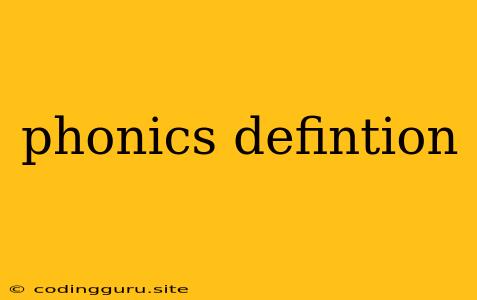What is Phonics? Unlocking the Code to Reading
Have you ever wondered how children learn to read? It's not just about memorizing words, but understanding the relationship between letters and sounds. This is where phonics comes in.
Phonics is a method of teaching reading that focuses on the relationship between letters and sounds. It helps children learn how to decode words by understanding the sounds that each letter or letter combination represents.
Why is Phonics Important?
Phonics is essential for developing strong reading skills. Here's why:
- Building a Foundation: It provides a foundation for understanding the alphabetic principle, which is the understanding that letters represent sounds.
- Decoding Skills: Phonics helps children decode unfamiliar words, allowing them to read fluently and independently.
- Spelling Skills: Learning the sounds of letters helps children spell words correctly.
- Reading Comprehension: When children are able to decode words easily, they can focus on understanding the meaning of the text.
How Does Phonics Work?
Phonics involves teaching children the sounds of individual letters and letter combinations. This is often done through:
- Explicit Instruction: Teachers explicitly teach the sounds of letters and how to blend them together to form words.
- Phonics Charts: These charts visually represent the letter-sound correspondences.
- Practice Activities: Children engage in activities that reinforce their understanding of letter-sound relationships, such as:
- Sounding out words: Children practice saying the sounds of each letter in a word and blending them together.
- Rhyming: Children identify words that sound alike.
- Word building: Children create words using letter tiles or magnetic letters.
Examples of Phonics in Action
Here are some examples of how phonics is used to teach reading:
- "c" says "k" in "cat"
- "a" says "short a" in "cat"
- "t" says "t" in "cat"
To read the word "cat," children would sound out each letter: "k-a-t" and then blend the sounds together to form the word "cat."
Types of Phonics Programs
There are various phonics programs available, each with its own approach and methods. Some common types include:
- Synthetic Phonics: This approach emphasizes teaching the sounds of individual letters and blending them together to form words.
- Analytic Phonics: This approach focuses on analyzing words that children already know to identify the sounds of letters.
- Embedded Phonics: This approach integrates phonics instruction within the context of reading real books.
Benefits of Phonics
Phonics offers numerous benefits for children learning to read:
- Increased Reading Fluency: Children who are proficient in phonics can read more smoothly and quickly.
- Improved Spelling: Understanding letter-sound relationships helps children spell words correctly.
- Boosted Confidence: When children can decode words, they feel more confident in their reading abilities.
Conclusion
Phonics is a powerful tool for teaching reading. By understanding the relationship between letters and sounds, children develop strong decoding skills, read fluently, and gain confidence in their reading abilities. It's a fundamental building block for reading success.
